

I am now at the point of making the rear trailing arms, the book ones are non adjustable, I have seen ones on cars the are adjustable - is there any
real advantage?
I am pretty confident that the chassis is dead square, should I bother with the extra effort and expence?
Mark
No! Get it on the road and get driving, you can modify it later if needs be.
I would make them adjustable, that way any slight discrepency in the chassis can be dialed out..
Making them adjustable was v. easy, 10mm rose joint at the axle end. I used a female and welded a bolt into the tube. Simple and adjustable as my measuring was never that good! Also used one at the axle end of the panhard rod. Let me know if you want details.
Been discussed b4.. but, i have just fitted 12mm rose joints and THEY look kinda flimsy! 10mm... i am not a pro, but they must look really iffy? 
Dear People
I refer you to my previous posting. Get it on the road, if you make it too complicated it will take forever. Use Chris G as an example, 6 years and
counting. Ask him what he would do if he was starting again. 'Keep it simple stupid' is the quote I believe!
I'm tempted to tell the Plastic tank man to get stuffed*but*If I was starting again mine would be the simplest car possible, that is true - It's the
twidly bits that take the time.
Anyway mines finished, there's no front brakes on yours!!
Cheers
Chris
i can go with the keep is simple.
However, as soon as my car is finished i just know it will all be worth it and i wouldnt have done it any other way!
Personally, if i was real;ly sure I had everything square, I would have used bushes. on my car I used rose joints everywhere. Just to give that bit of
adjustment if needed. However, its costly - over 15 quid a joint if you get a BIG decent 16mm one. Perhaps 12mm is ok for the rear.
Bushes are cheaper and easier.
atb
steve
Oh yes there are, although there's 4 pots and vents on one side and 2 pots and solid on the other!
Oh yes there are, although there's 4 pots and vents on one side and 2 pots and solid on the other!
Chris,
isn't that a little dangerous. Must pull a bit!
Col
10mm rose joints have kept the back of Jon's car together - and some of you have seen how he drives!!
Macca, don't be silly, i just have'nt got round to doing the other side yet!
And Mr Jasper re:rose joints and Jon Ison, now who was it who ripped his joints out of the arms a few weeks back? You can ask him the details!
10mm Rose joints? What's your second car, an ambulance?
Unless you're using the heavy duty shank (12mm) chrome moly joints from Aurora or National, forget it.
If you don't believe me, ask our friend Cymtricks to run a FEA on the over-the-counter-mild-steel 10mm joints in this application.
On the other hand though, they won't be any worse than welded-on bushes, judging by the standard of some of the welding I've seen on this list! 
If it helps.....i run a Tvr Tuscan chalenge car and on that we use 1/2" rose joints everywhere but with 8mm bolts this car weighs in at 850kg and has 460hp on 11" wide slicks the joints usualy last a couple of seasons but aint cheap.....about 3 grand for the whole car (22 joints)
Fifteen quid each, thats £60, that would only leave me £190!!!!!!
I used the trailing arms off a Nissan Bluebird. They are the right size, can be adjusted and only require a bit of elbow grease to remove from the
car. Also used one to make an adjustable panhard rod. Easier than fabricating and cheaper too. What could be simpler?
Oh poo really? - Maybe I'll be checking me welding....He didn't break the joints though?????
quote:
Originally posted by Jasper
10mm rose joints have kept the back of Jon's car together - and some of you have seen how he drives!!
According to Jon they were high grade expensive ones ........ time will tell!!
wich will go 1st ????
a 10mm joint rated at 6000psi or
a 16mm joint rated at 4000psi ???
nuff said, its not the size that counts.....
and chris, you saw the failed trailing arms 1st hand, seem the rememember the joints where still intact and the weld/pipe and failed......4000 miles
on them no visible or detectable wear in them as yet,,
on these theroys an F1 car should be using 40mm joints ?????
bit like saying a 900cc bike engine can't out accelerate a 2000cc lump of old iron.....
any way enough of all that, it's the rating not the size that counts.....,
quote:
Originally posted by Mark Allanson
Fifteen quid each, thats £60, that would only leave me £190!!!!!!
Sorry to be a scare monger, but when it comes to building something capable of traveling at speed in public places, then I worry about under-rated
rodends and shonky welding.
Ian Pearson points out the Nissan Bluebird trailing arms fit. They'll be over engineered (from a heavier car/manufacturers safety margin), so won't
fall apart in a hurry.
As Viper states, rodends will give a harsh ride, but if you're determined to use them to compensate for chassis misalingment, then ask your bearing
supplier for some catalogues, and do a bit of research as to which rodends are suitable.
There are dozens of different types, and I suspect the cheap ones mentioned before, are only suitable for linkages in industrial applications. The
good quality automotive grade ones aren't likely to be kept lying around, as they are neither cheap, nor in widespread demand.
Look on the web for rodends made by the likes of Aurora, FK, Alinabal, Tuthill, National etc.
As most of you are UK based look up www.resb.co.uk they carry a good selection.
If price/availability is a problem, there's a comparrison chart on my site www.rortydesign/rodend_interchange.jpg
Some custom/hot rod suppliers have beautiful investment cast T-ends, which accept polyurethane bushes and crush tubes (see pic). They would give you
the adjustability, and some degree of ride comfort.
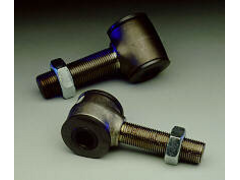

Rescued attachment T_ends.jpg
This is the standard of welding that scares me, and shouldn't be used to repair a gate, let alone for fabricating suspension components.
Looks scarey? It was sourced from this list! 




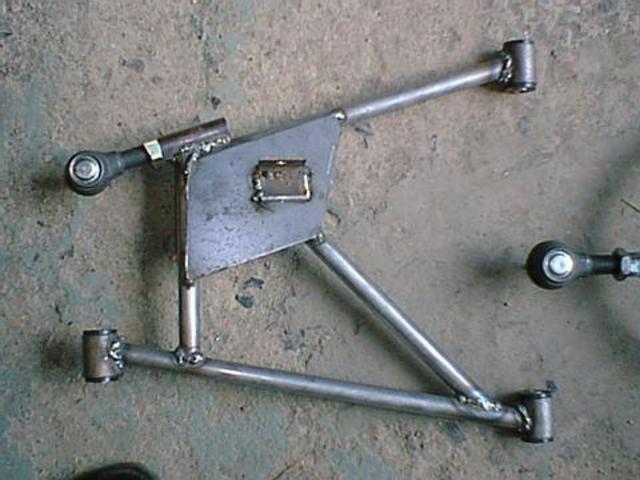
Rescued attachment deathtrap.jpg
Bob,
Nice photo, but where did you get it from as I'm unable to access the photo section.
Am I doing something wrong?
Cheers Col
the bosses morgan aero 8 as i said in another post has like a half and half thing they look like rod ends but are actually bushes
dot no where to get em or cost but if used will give u the adjustment the same as rod ends plus can be easily swapped u ever wish to do so but wont
give the harsh ride that rod ends do
therfore everyones a winner
if u can find em
[Edited on 20/11/02 by johnston]
quote:
Originally posted by johnston
the bosses morgan aero 8 as i said in another post has like a half and half thing they look like rod ends but are actually bushes
dot no where to get em or cost but if used will give u the adjustment the same as rod ends plus can be easily swapped u ever wish to do so but wont give the harsh ride that rod ends do
therfore everyones a winner
if u can find em
[Edited on 20/11/02 by johnston]
quote:
Originally posted by Jon Ison
wich will go 1st ????
a 10mm joint rated at 6000psi or
a 16mm joint rated at 4000psi ???
nuff said, its not the size that counts.....
God, I laughed!
I really stirred up a hornet's nest with that one. I've had so many emails.
Steve Gusterson: I tried replying to your emails, but they kept coming back.
Look, it's like this, not all rodends are equal. Some are of 2 piece construction, and some are 3 piece. Some are metal on metal, and some have Teflon
(PTFE) liners. Some are made from mild steel, some are stainless, and some are chrome moly etc etc.
Depending on the materials, a 1/2" National brand male rodend, for example, can have an ultimate radial capacity between 7,106lbs and 23,632lbs. You
pays your money, you takes your choice!
Generally speaking, I use the teflon lined ones for wishbones etc. The Teflon does add a little "stiction", but is not significant. The liner acts as
a wiper, and keeps all manner of sh1t out of the joint, and they never need lubricating. The metal on metal ones do need lubricating, and will
therefore attract dirt and dust, turning it into grinding paste, and the rodends will chop out in no time.
Everyone has asked where I got the nice cast T-ends. I'm not sure, but I think they're made in the States, as the ones I get here are identical to the
ones I used to get when I lived in England (with the exception of the colour of the polyurethane bushes).
I seem to remember buying them from one of the 32 Ford-fibreglass-hot rod type blokes in hampshire. Check out Street machine or Custom Car for
connections.
The T-ends are 5/8" UNF, and either straight or angled.
As for that glorious bit of welding I highlighted, I found it on a locost site, searching through the links, but I won't personally embarrass the
bloke any further.
Finally, to the imbecile who emailed me, saying he saw nothing wrong with the welding in the pic, and fired a good salvo of expletives at me for
having a go at someone's attempts to build their dream car, the name you used at the bottom of your email, doesn't match the one on the header! And,
if your welding really isn't as good as that in the pic, I suggest you double the premiums on your life insurance policy!



Hi
perhaps you typed the address in wrong, cos I have an always on cable connection thats been up and working for the last few hrs. address typos? (Im
well used to them being an exponent of them myself).
I have seen the 'bushed rod end' somewhere on the net - if I find it again I will let on.
Agreed, there are all those types of ends. Even similar types have wide variances of load ratings.
The ones I have are supposedly self lubricating.
As far as crap in them is concerned, a company in the UK called rota precision do boots and covers for them. The boots are really bulky, but the
covers are quite dinky. They are basically a washer with a concave rubber type seal that goes each side of the joint and forms a 'seal'.
The joints wont last forever, but on a car thats driven a couple thousand miles a year in the dry on well made british roads I dont think they will
suffer too massively.
atb
steve
[Edited on 20/11/02 by stephen_gusterson]
Steve, I actually just hit "reply", so I don't know which gremlin ate what.
Those sealing washers are called Seals-It, and aren't worth considering. The muck still gets in behind them, but doesn't like coming out! The boots
are similar.
I'll see if i can find a receipt for those bushed ends, which should give me an address of where I bought them. I'm a bit anal, I keep all the
receipts for each build, I just have to remember where I put the folder!
To anyone's knowledge, has a locost, or any other home built car ever been turned down by SVA on the standard of welding?
I just found a link for both adjustable arms, and adjustable bushes. Take a look at the specs of the materials used in the arms!
www.rdent.com/pages/parts.html

Good find, Rorty
the full link is http://www.rdent.com/pages/parts.html
John
surly those studed bush holders couldnt b hard to make or have an engineering firm to make up
quote:
Originally posted by johnston
surly those studed bush holders couldnt b hard to make or have an engineering firm to make up
thats why i said engineering firm
but have you not welded your own whishbones i wold call them fairly cruical 2
Johnston: Steve has a point. There's a difference between the combined strength of joints on a wishbone, and a single pivot like one of these
adjustable bushes. With the wishbone, the strength of the welds is shared out around several points, whereas it attaches to the car at only two
points....the adjustable bushes. If the welding on the fabricated adjustable bushes is in the least bit suss, that could lead to catastrophy.
Why doesn't one of you blokes who has connections with/proximity to a reputable engineering firm, approach them to manufacture these adjustable ends.
A simple jig to hold the two components securely for welding is all that's required. The correct materials, neatly TIG welded would be both strong,
and good looking.
These can then be used by the group as a whole, and possibly marketed even further afield, as the street rod types could also be interested in them.
I'm quite happy to do some CAD drawings to kick it all off. I would suggest using tube which is both common, and suitable for both the outer sleeve,
and the crush tube. The crush tube would be best made from stainless, as it won't seize onto the bolt, and won't need plating for asethetics either.
I've noticed from other posts on this list, the regular questions/problems regarding obtaining the polyurethane bushes. This would be a good
opportunity to source a standard size of PU bush, which I could incorporate into the drawing (if no body else with CAD want's to put their hand up for
the job).
Manufacturers such as Polybush, Powerflex, SuperFlex, etc. all make "universal" bushes, and AFAIK, SuperFlex supply a stainless crush tube as
standard.
Let me know if I can help.
These welded adjusters are used on those lardy great American cars by some of the drag racing fraternity for their four bar set-ups.
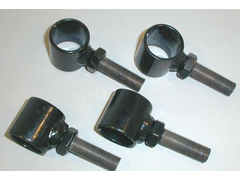

Rescued attachment studed_bushes.jpg
5/8" mild steel over-the-counter rodend, that was asked to do more than it was designed for.
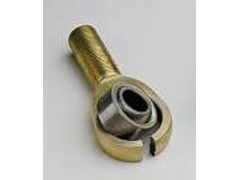

Rescued attachment broken_rodend.jpg
If enough people ar interested in these i might be persuaded tofabricate some, same goes for mounting brkts etc, just let me know..
quote:
Originally posted by Viper
If enough people ar interested in these i might be persuaded tofabricate some, same goes for mounting brkts etc, just let me know..
Why use a 10mm joint if you could actually get the space to fit a 16mm or so one?
Could turn that one round, why use 16mm when 10mm will do, in my case cosmetics n weight, i dint want the "tractor" look around my rear end, but each
to his own.... myself, i am perfectly happy with my choice.....
4000 miles later no problems, a fair few of wich have been flat out on the track, and not too far off on the road...........
[Edited on 23/11/02 by Jon Ison]
i can understand that staetment Jon, apart from are not the joints all covered up by the arches ?
The big weight saving issues on road blasters always seem to need compromises. Saving 1 kilo on a set of joints on the risk of my life would not be
worth it for me.
atb
steve
quote:
Originally posted by johnston
thats why i said engineering firm
but have you not welded your own whishbones i wold call them fairly cruical 2
Unless you are an ace welder (im not) just welding a stud on the tube might tend to cause it to rip out. There is a lot of leverage and shock loads
involved. Also, as steel for bolts etc is high tensile high grade, I wonder what welding that does to its strength?
My idea basically uses a machine screw, bolted to a U shaped saddle, that is then slipped over the tube and welded down the whole length of the tube.
A nut is used to hold the bolt in place.
The head of the bolt is hard against the tube. If there are no concerns on welding the bolt head, this could also be welded to the tube.
Belt and braces I recon.
I cant see how this would be anywhere near as stressed as welding a stud on at one small point. Providing that you can get inch rhs over your bush
tubes, its something you can do easily in the garage. If the bolt head is too big, you could cut some bigger flats on it to allow it to go in the rhs
channel.
atb
steve
[Edited on 24/11/02 by stephen_gusterson]
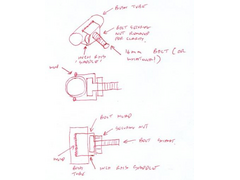

Rescued attachment joint.jpg
neatly TIG welded would be both strong, and good looking
Not strong enough though,the ones in your pic have been either Mig or stick welded, with a fillet of approx 6mm,if i was stick welding them i would go
for a low hydrogen rod, to increase strength. Mig welding would be fine. The weak point in the design is actually the tube itself,as it is quite thin
wall,any undercutting of the weld could lead to joint failure, but welded properly the weld would actually be stronger than the tube itself. using TIG
you would struggle to attain a suitable sized weld .
why doesnt someone that knows what their talkin about work out what load would go through the rod ends on trailing arms and wishbones on a book locost
for the most popular set ups
1.6 x flow
2.0lt pinto
and a bike engine (no idea wats most popular)
and cossie
then i'm sure chris w will make a file section if we all ask nicely
and then the nice very smart person could post said list with the usual disclaimers
then us not so smart people could decide weather to go for cheaper but big rose joints or smaller and more expensive ones
then it will be a bit more than guesswork when any future builder start building or any body else can see their usin underrated joints will know to
change up.
I really like Steve's design, and M16 bolt would be a good choice because the pitch is 2mm, so each 180 degree turn would be 1mm, handy for adjustment
purposes.
Also the design would be quite easy to make and keep straight, the design means that the bolt comes out perpendicular to the tube, something that
would require a jig otherwise.
Well done
John
quote:
Originally posted by interestedparty
I really like Steve's design, and M16 bolt would be a good choice because the pitch is 2mm, so each 180 degree turn would be 1mm, handy for adjustment purposes.
Also the design would be quite easy to make and keep straight, the design means that the bolt comes out perpendicular to the tube, something that would require a jig otherwise.
Well done
John

quote:
Originally posted by johnston
why doesnt someone that knows what their talkin about work out what load would go through the rod ends on trailing arms and wishbones on a book locost for the most popular set ups
1.6 x flow
2.0lt pinto
and a bike engine (no idea wats most popular)
and cossie
then i'm sure chris w will make a file section if we all ask nicely
and then the nice very smart person could post said list with the usual disclaimers
then us not so smart people could decide weather to go for cheaper but big rose joints or smaller and more expensive ones
then it will be a bit more than guesswork when any future builder start building or any body else can see their usin underrated joints will know to change up.


quote:
Originally posted by stephen_gusterson
......Possibly cos we are mostly amateurs, and those on here that do have simulation software probably find its not part of their build so why bother.
Perhaps cymtricks will prove me wrong!
I still cant understand why we have to apply all that extra science when you could just simply use a bigger joint?
I've just bought some trailing arms off a Nissan Bluebird-£15- three of the four are adjustable.
Spooky at it is , the non-adjustable one is the same lenght as a book one. Therefore, if you really want adjusable arms this is a pretty good route to
go.
I need to replace the bushes and am not sure how much this will be yet , but it shouldn't be too costly
The only reason I went down this path was that my self made arms were a reallly tight fit into my brackets and I found that after trial fitting the
bushes got pretty mangled------A lesson here I think !!!!1
steve
the reason i suggested someone wit brains makes up a list is cos it would be to easy for someone who has no experiance of building or workin on cars
or any engineering background to look at a joint on someones car and go
"oh look he's only got 10mm joints on his cossie powered car they be more than adequate on mine"
only not to relise that there can be a load rating difference and those small joints could be very high quality F1 style joints
Hi Alan
I am in agreement with you.
I dont have a clue on the following factors re the front suspension :
1. how much weight shifts forwards on an emergency stop.
2. how the effect of G's multiplies that weight shift, and from what to what!
3. The effect of hitting a pot hole at the same time.
4. how the static loadings of the joints actually translate, as a real life load factor, to the above scenarios.
I know the static ratings of my rod ends, but how they will cope on a car, bu%^er knows!
Thats why I went as big as I felt was sensible. However, if I use my bush based ajustable ends, I recon that falls into your 'see what works for
others' category - if they work on locost and spitfires, I should be taking a fairly safe low risk route rather than wondering if the next bump is
gonna make something break.
atb
steve
[Edited on 24/11/02 by stephen_gusterson]
quote:
Originally posted by johnston
steve
the reason i suggested someone wit brains makes up a list is cos it would be to easy for someone who has no experiance of building or workin on cars or any engineering background to look at a joint on someones car and go
"oh look he's only got 10mm joints on his cossie powered car they be more than adequate on mine"
only not to relise that there can be a load rating difference and those small joints could be very high quality F1 style joints
i have seen it all to often in rallying circles when people say
" i get my rod ends from y cos x is too deer"
the trouble is y's own cars usully crash out more often cos of suspension failure
i know of 1 mk2 with coil overs leaf springs and located by trailing arms as well with one arm doing next too nothing cos theres that much slap in
cheap rose joint what fears me more is none of the so called expert drivers can feel it or hear it knocking
DUH!!!!
who spotted the delibrate mistake the carmentioned above doesnt have coilovers and leaf springs it has leaf springs and turreted for coil overs but is
just usin the upright dampers
Steve,
I don't think you need to worry so much about rod end joint failure.
Surely the loading in the (chassis-side) joints is in compression and tension rather than shear as you are worried about? Especially with your
comparison with F1 cars.
As I understand it the loads from the wheel are transmitted inwards on rear A-arm and outward on forward A-arm. This is of course while vehicle is in
forward motion. Whilst stationary both forward and rear A-arm are in tension.
If the loads through the joints were in shear then there would be problems with binding and even possibly bending of brackets, as all the load would
go through rear half only of bracket.
Of course this cannot acount for shock loads, which is why you need joints with a reasonable side load rating.
Just my opinion!
Terry
Flameproof jacket at the ready!
quote:
Originally posted by Bull
Steve,
I don't think you need to worry so much about rod end joint failure.:Just my opinion!
Terry
Flameproof jacket at the ready!
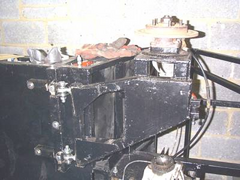

Here here!
I think this is all getting a bit in-depth for the accumulated level of professional knowledge. No offence to anyone.
I'm no professional, I have vast experience though, gained through failures and successes.
Alan made a valid point: if you don't have the knowledge, or analysis capabilities, look to others who use similar materials, in similar
situations.
I've built race cars for both on and off road use, and over the years, have learned what works and what doesn't. Don't take my word for it though, as
I say, I'm not a professional anything.
Do look around at who else is using what, and see if it works for them, but don't get sucked into "well, he's using 10mm Rose joints in his 1200kg
car, so they'll be good enough for me" type scenarios.
As I pointed out in an earlier post, there are 10mm Rose joints, and then there are 10mm Rose joints. Ask the person with the 1200kg car exactly what
brand and quality of joint he's using.
I gained most of my knowledge racing off road, in cars with full roll cages. No one has ever been killed hitting a bush at 1200kmh in a full cage.
You lot don't have full cages, and will travell on public roads!
To be honest Steve, and no offence, but I think your suggested adjustable ends are overkill on several levels. They'll be unecessarilly heavy(I know
you'd sooner put safety before weight), but I really don't think they'd be any stronger than a well assembled bolt and tube, properly TIGged.
Have a look at those black coated, fabricated, adjusters I posted before. They're used in sub 2000kg drag cars, and they're just MIG welded
together!
I use TIG welded 1/2" UNF clevises on the inner ends of my tie rods. I've bent plenty of tie rods when either banging wheels with other racers, or
from hitting ruts, but I've never replaced or repaired a clevis.
Much earlier, Rorty posted a pic of a cast adjustable end that is typically used on American street rods. I just wanted to say that I've seen these
successfully used on a number of rods and those typically weigh in at over 2500lbs and most often with 250-350hp engines. They hold up just fine.
Can't say I've ever seen them in 1/2", but they're probably available.
They are not too expensive and can be had from Speedway Motors. Look in the street rod section under "rod
ends".

BTW, I've personaly ordered things from them and have been very happy with the service. Can't say what it would be like to buy from the UK, but here
in the States it's been a pleasure.
quote:
Originally posted by Rorty
To be honest Steve, and no offence, but I think your suggested adjustable ends are overkill on several levels.
Going back to the Bluebird trailing arms, are these the true trailing arms or the twin track control arms with run transversley? I had a look today
under a scrapper and the true trailing arms were not adjustable but the TCA's were.
They also looked like they were attached with M12's and not M10's - can anyone confirm?
Thanks
Mark